17 Iconic Movie Outfits From The 1970s That Will Blow You Away
The 1970s gave us more than just groovy tunes and lava lamps—it delivered some of the most unforgettable fashion moments in film history. I still remember being a wide-eyed kid, glued to the TV, completely mesmerized by the glitter, glam, and glorious bell-bottoms on screen.
I begged my mom to let me dress like the characters—though, to her credit (and my embarrassment now), she firmly drew the line at the Foxy Brown halter top. Movies in the ’70s weren’t just about the story—they were full-blown fashion statements.
From the glittery chaos of Saturday Night Fever to the space-age glam of Barbarella and the effortless cool of Annie Hall, every costume told a story, oozing with personality and cultural punch. These weren’t just outfits—they were attitudes. Disco fever brought sequins, wide collars, and platforms, while sci-fi flicks dared to imagine what we’d wear in the future (turns out, lots of silver and spandex).
And let’s not forget the street-smart sass of Blaxploitation heroines or the punky rebellion simmering toward the decade’s end. These looks didn’t stay on screen—they jumped off it, shaping real-world fashion and inspiring designers even today. Simply put, the ’70s didn’t just dress the part—they owned it.
1. John Travolta’s White Disco Suit in ‘Saturday Night Fever’
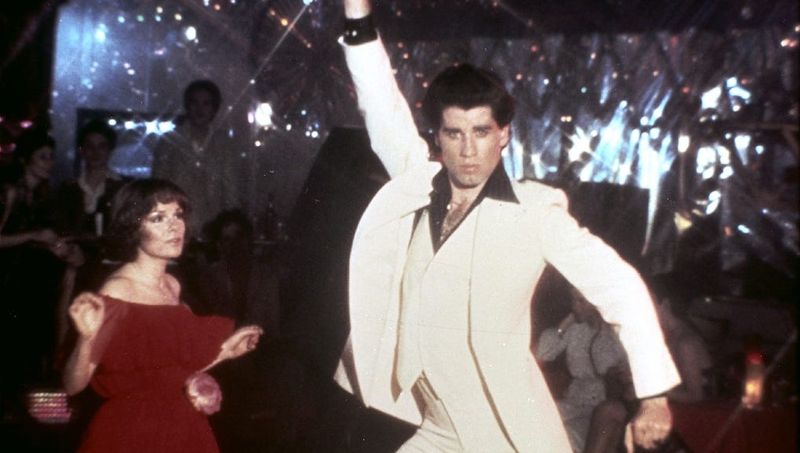
The moment Tony Manero struts down the Brooklyn streets in that impeccable white three-piece suit, cinema fashion history was forever changed. I once attempted to recreate this look for a costume party and learned the hard way that polyester doesn’t breathe!
The iconic ensemble – complete with black shirt, white vest, flared pants, and Cuban heels – became the ultimate symbol of disco culture. Designed by Patrizia Von Brandenstein, this outfit wasn’t just clothing; it was a character statement that screamed confidence and dance floor domination.
What makes this suit legendary is how it transcended the film to become the defining look of an entire era. Even today, you can’t mention 1970s fashion without picturing Travolta’s finger pointing skyward in that pristine white getup. The suit sold at auction in 2019 for a whopping $145,000 – proving some movie magic never fades. Fun fact: Travolta actually helped choose the suit himself, insisting on something that would highlight his dance moves while maintaining that cool street swagger.
2. Diane Keaton’s Androgynous Wardrobe in ‘Annie Hall’
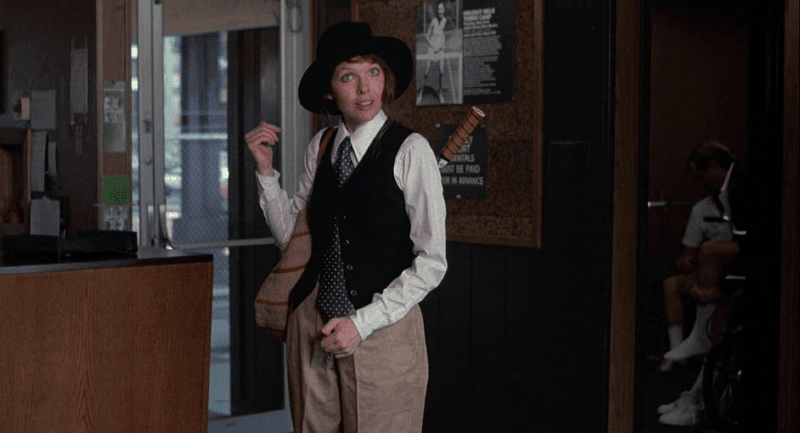
Who knew that men’s clothing could look so fabulous on a woman? Diane Keaton’s revolutionary wardrobe in ‘Annie Hall’ (1977) wasn’t just costume design – it was fashion rebellion in motion. The baggy trousers, oversized blazers, vests, and those iconic ties created a look that screamed individual style while whispering gender-bending confidence.
What’s absolutely wild about this fashion moment is that most of these clothes came from Keaton’s personal closet! Costume designer Ruth Morley initially hated the androgynous look, but director Woody Allen famously intervened with, “Leave her alone, she’s a genius.” The outfit became so influential that Ralph Lauren’s entire women’s collection that year practically mirrored Annie’s aesthetic.
I remember borrowing my dad’s necktie and vest in middle school after watching this film on VHS, thinking I was the coolest kid ever. The beauty of Annie Hall’s wardrobe is how it balanced masculine structure with feminine charm – those wide-brimmed hats and loose layers somehow managed to be both quirky and sophisticated. This wasn’t just 70s fashion; it was the birth of power dressing with personality that continues to inspire designers five decades later.
3. Carrie Fisher’s White Princess Leia Gown in ‘Star Wars’
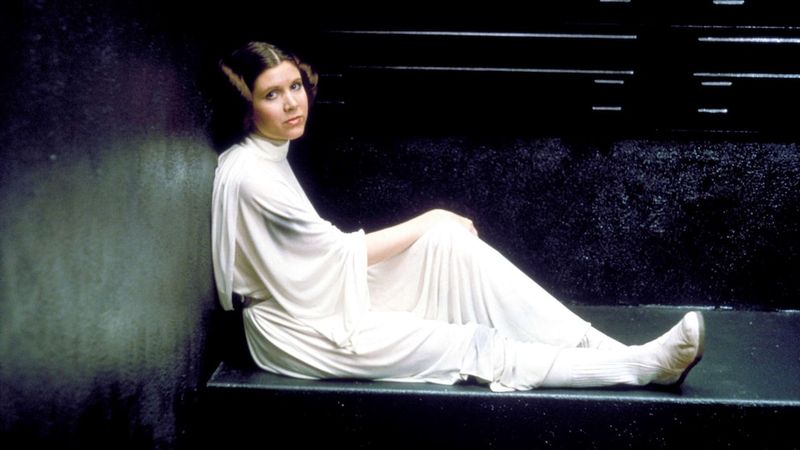
Princess Leia’s flowing white gown wasn’t just a costume – it was a galaxy-altering fashion statement that launched a million Halloween costumes (including mine in fifth grade). The simple, monastic design with its high neckline and long sleeves created a perfect canvas for Fisher’s iconic side buns, forming one of cinema’s most recognizable silhouettes ever.
Costume designer John Mollo crafted this deceptively simple gown to reflect Leia’s dual nature – both royal diplomat and rebel fighter. The dress’s practical, unadorned style stands in stark contrast to the flashy, ornate outfits typical of sci-fi films before Star Wars. Its brilliant white color immediately established Leia as a symbol of hope and purity against the dark, mechanical Empire.
What’s fascinating is how this gown managed to be simultaneously futuristic and timeless. The hood, the draping, the minimalism – it all feels both ancient and ahead of its time. Despite being from 1977, this look hasn’t aged a day. And let’s be honest, those side buns? Pure fashion genius. They completed a silhouette so distinctive that you can identify Princess Leia from just her shadow. The gown proved that powerful women don’t need revealing outfits to command attention in film.
4. Pam Grier’s Red Halter Pantsuit in ‘Foxy Brown’
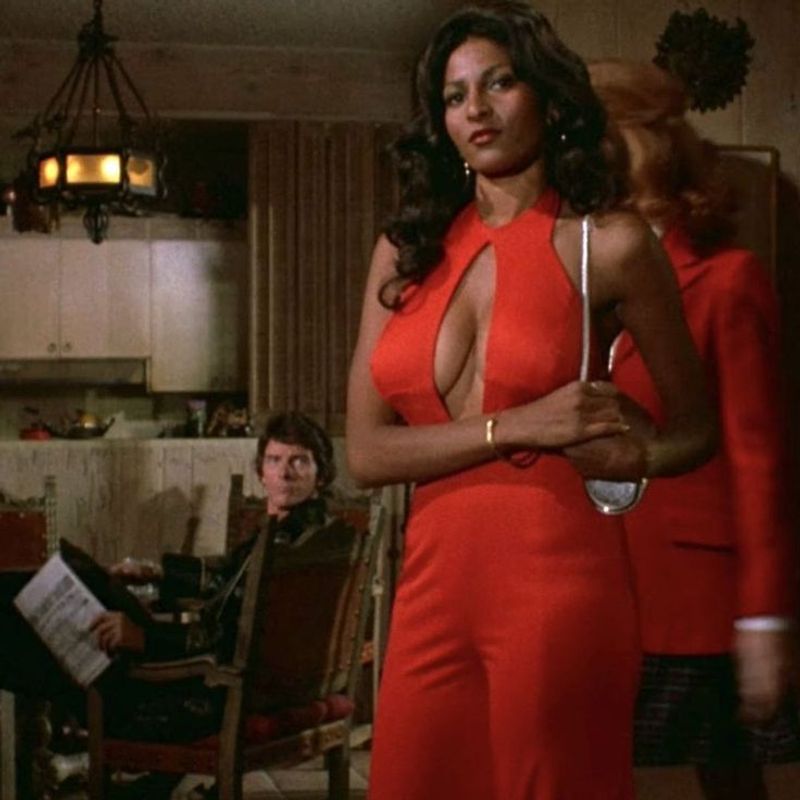
Holy smokes! When Pam Grier burst onto the screen in that red halter pantsuit, she didn’t just steal scenes – she redefined what it meant to be powerful, sexy, and unapologetically fierce. As a teenager discovering Blaxploitation films, I was mesmerized by how her wardrobe combined bold femininity with don’t-mess-with-me attitude.
Costume designer Ruthie West created outfits that celebrated Grier’s curves while emphasizing her character’s strength. The red halter pantsuit, with its plunging neckline and wide-legged pants, became the standout piece that encapsulated everything revolutionary about Foxy Brown. It wasn’t just revealing – it was revealing on Foxy’s terms, worn by a woman who used her sexuality as one weapon in an arsenal that included guns, martial arts, and razor-sharp intelligence.
The outfit represented something revolutionary in 1974 – a Black female protagonist whose clothing choices were both sensual and powerful. The bright red color symbolized danger and passion, while the pantsuit format (rather than a dress) subtly communicated that Foxy could kick butt just as effectively as any male action hero. This look influenced everything from 70s fashion to hip-hop aesthetics decades later, with artists like Beyoncé and Rihanna channeling Foxy’s bold style in their performances.
5. Robert Redford’s Pink Suit in ‘The Great Gatsby’
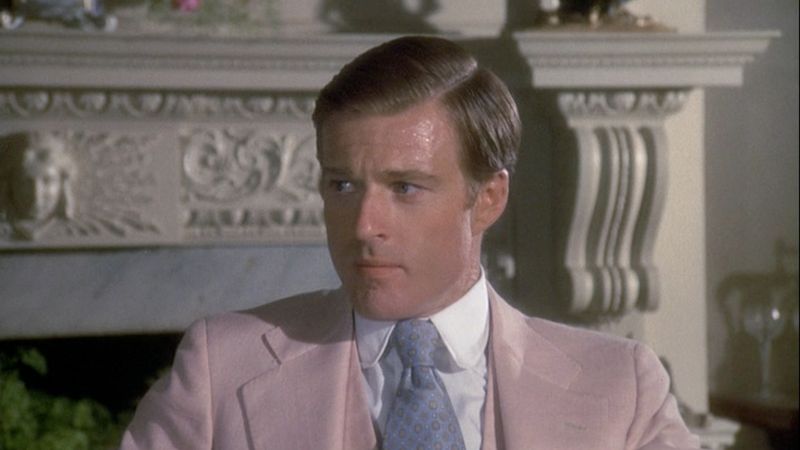
The moment Robert Redford appeared on screen in that impeccably tailored pale pink suit, men’s fashion was forever changed. I recall my grandfather, normally a strictly navy-blue kind of guy, suddenly asking about “those pastel suits” after watching this film! Designed by Ralph Lauren (who won an Oscar for the film’s costumes), Gatsby’s ensemble perfectly captured the character’s combination of new money flashiness and desperate desire for sophistication.
The three-piece suit featured a pale pink jacket with matching vest and trousers, paired with a crisp white shirt and pink-and-white striped tie. What made this outfit revolutionary was how it maintained masculine lines while embracing a color traditionally considered feminine. The result wasn’t just fashionable – it told Gatsby’s entire story without a word of dialogue.
Lauren’s genius was creating costumes that felt authentic to the 1920s while simultaneously capturing the 1970s’ obsession with nostalgic glamour. The suit became so influential that men’s fashion saw an immediate uptick in pastel colors and three-piece suits. Even today, when designers want to reference wealth with a hint of vulnerability, they often circle back to this iconic look. The outfit perfectly embodied Gatsby’s romantic idealism – beautiful, aspirational, and ultimately too fragile for the harsh realities of his world.
6. Sylvester Stallone’s Tiger Jacket in ‘Rocky II’
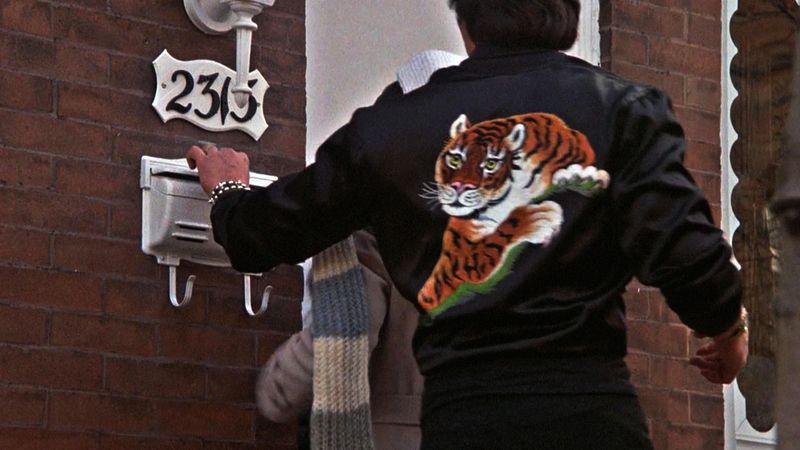
Nothing says “I’m a champion with unexpected style” quite like Rocky Balboa’s black satin jacket with that magnificent tiger embroidered on the back. The first time I saw this jacket as a kid, I begged my parents for something similar (ended up with a tiger patch ironed onto my backpack instead).
This wasn’t just any piece of outerwear – it was a character-defining statement. The sukajan-style souvenir jacket perfectly captured Rocky’s evolution from underdog to icon while maintaining his street-level authenticity. Designer Robert Cambel created a piece that balanced toughness with unexpected flair, much like Rocky himself.
What makes this jacket legendary is how it represents Rocky’s newfound success without abandoning his roots. The tiger symbolism couldn’t be more perfect – powerful, beautiful, dangerous when provoked. Stallone wore it with such natural confidence that the jacket became inseparable from the character’s identity. The jacket sparked a massive trend in the late 70s, with similar styles appearing everywhere from high school hallways to disco dance floors. Even today, fashion designers regularly reference this iconic piece in their collections, proving that true style, like a champion fighter, never stays down for the count.
7. Jane Fonda’s Futuristic Bodysuit in ‘Barbarella’
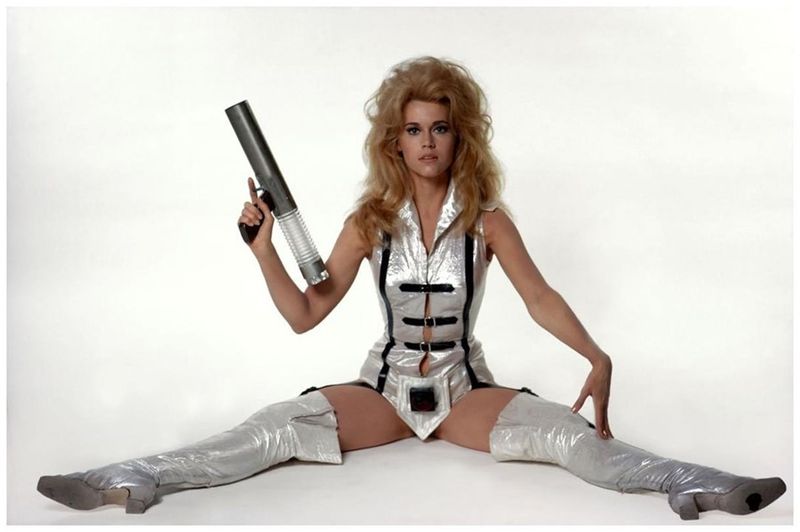
Barbarella’s space-age bodysuit wasn’t just ahead of its time – it was from another dimension entirely! Though the film debuted in 1968, its fashion influence dominated the 1970s sci-fi landscape and beyond. The first time I saw Jane Fonda’s transparent plastic breastplate outfit at a midnight screening in college, I nearly spilled my popcorn in amazement at its audacious design.
Created by fashion designer Paco Rabanne, this provocative ensemble featured a clear plastic panel strategically covering Fonda’s chest while leaving little to the imagination. The futuristic bodysuit combined sexuality with space-age materials in a way that perfectly embodied the film’s playful approach to sci-fi. What’s remarkable is how the costume balanced revealing elements with an almost architectural quality – it wasn’t just sexy; it was boundary-pushing design.
This iconic look inspired countless sci-fi costumes throughout the 70s and continues to influence fashion today. The bodysuit’s combination of metallic elements, plastic, and form-fitting design created a template for futuristic female characters for decades to come. From runway collections to pop star performances, Barbarella’s influence remains unmistakable. The costume perfectly captured that uniquely 70s vision of the future – one where space exploration and sexual liberation went hand in hand, creating a visual language for female empowerment that was simultaneously objectifying and oddly liberating.
8. Al Pacino’s Disco Suit in ‘Saturday Night Fever’

Amidst the white-suited glory of John Travolta, Al Pacino’s sleek black three-piece in ‘Saturday Night Fever’ delivered a masterclass in disco-era menswear with a dangerous edge. I remember borrowing my uncle’s vintage suit jacket (complete with wide lapels) for a high school dance, trying desperately to channel that same intimidating coolness.
The genius of this outfit lay in its contrasts – the formal structure of a well-tailored suit combined with the sensual styling of a partially unbuttoned silk shirt and gold chains. Costume designer Patrizia von Brandenstein created a look that perfectly communicated Tony Montana’s dual nature: part ambitious businessman, part street hustler. The rich textures – wool suit, silk shirt, leather shoes – created a tactile luxury that screamed success while maintaining an underlying threat.
What separated this look from other disco-era suits was its restraint. While everyone else peacocked in wild patterns and colors, this outfit used subtle details like the precise width of the lapels and the perfect break of the trousers to communicate sophistication with menace. The suit became such a cultural touchstone that it influenced men’s fashion throughout the late 70s, with sales of similar styles skyrocketing after the film’s release. Even today, this look represents the ultimate in dangerous glamour – formal enough for business, stylish enough for the nightclub, and intimidating enough to command respect in any setting.
9. Richard Roundtree’s Leather Coat in ‘Shaft’
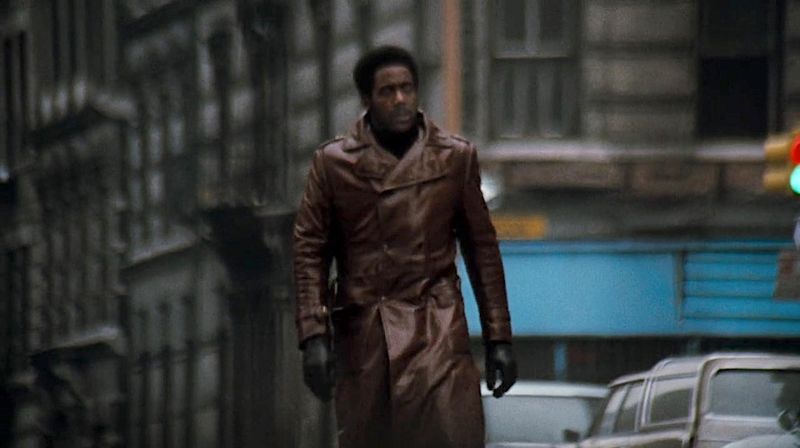
Can you dig it? Richard Roundtree’s brown leather trench coat in ‘Shaft’ (1971) wasn’t just an outfit – it was a revolution in black masculinity on screen. The first time I saw this film on late-night TV as a teenager, I immediately understood why my dad always insisted leather jackets were the coolest thing a man could wear.
This wasn’t just any leather coat – it was a full-length statement piece that moved like liquid power as Shaft navigated Harlem’s streets. Costume designer Joseph G. Aulisi created a look that perfectly balanced urban toughness with unexpected elegance. The coat’s rich brown color and supple leather texture conveyed luxury, while its practical length and no-nonsense styling screamed capability.
What made this outfit truly iconic was how it combined traditional masculine symbols (leather, dark colors, utilitarian design) with a distinctly Black cultural aesthetic. The coat became inseparable from Shaft’s identity as a man who operated outside the system while maintaining his own moral code.
Its influence extended far beyond cinema, inspiring a generation of young Black men to embrace fashion as a form of self-expression and power. The coat’s silhouette – fitted shoulders flowing to a dramatic length – created a distinctive profile that communicated authority before Shaft even spoke a word. Even fifty years later, when designers want to reference cool confidence, they still turn to this legendary look.
10. Faye Dunaway’s Beret and Scarf in ‘Bonnie and Clyde’
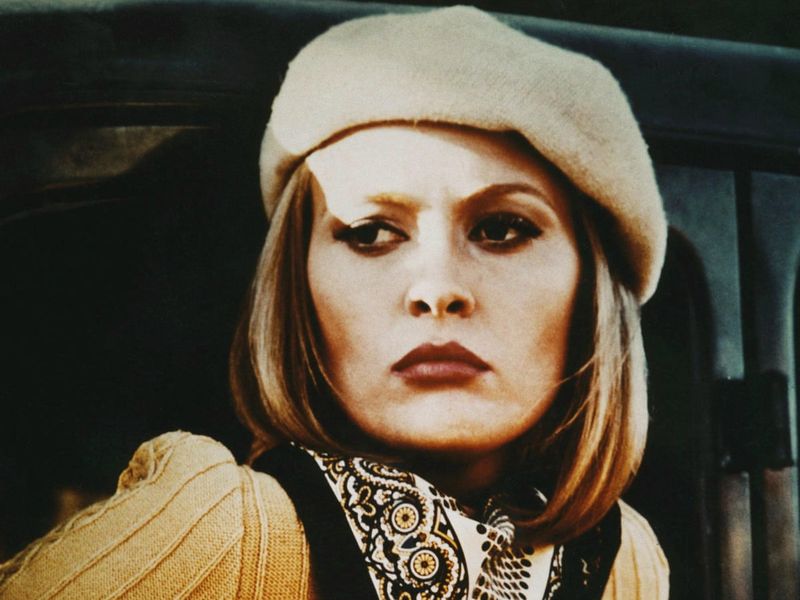
Though technically from 1967, Faye Dunaway’s beret and neckerchief combo in ‘Bonnie and Clyde’ created such a fashion earthquake that its aftershocks dominated 1970s women’s wear. My mom still talks about how every girl in her high school suddenly started wearing berets after this film hit theaters!
Costume designer Theadora Van Runkle created a revolutionary look that transformed Bonnie Parker from a Depression-era bank robber into a fashion icon. The beret, worn at a rakish angle, paired with a fitted sweater and that signature neckerchief, struck the perfect balance between feminine and dangerous. The outfit’s genius lay in how it used traditionally French fashion elements to create an unmistakably American outlaw aesthetic.
What made this look particularly influential was its accessibility – unlike elaborate gowns or expensive ensembles, this was fashion that ordinary women could actually recreate. Department stores couldn’t keep berets in stock as women rushed to capture Bonnie’s blend of criminal chic and carefree confidence.
The outfit’s influence extended throughout the 70s, with the beret becoming a symbol of artistic rebellion and feminine strength. Even today, when designers want to reference that perfect blend of danger and style, they inevitably circle back to Dunaway’s iconic look. The outfit’s enduring appeal lies in its contradictions – simultaneously practical and stylish, feminine and tough, vintage and timeless.
11. John Travolta’s Black T-Bird Jacket in ‘Grease’
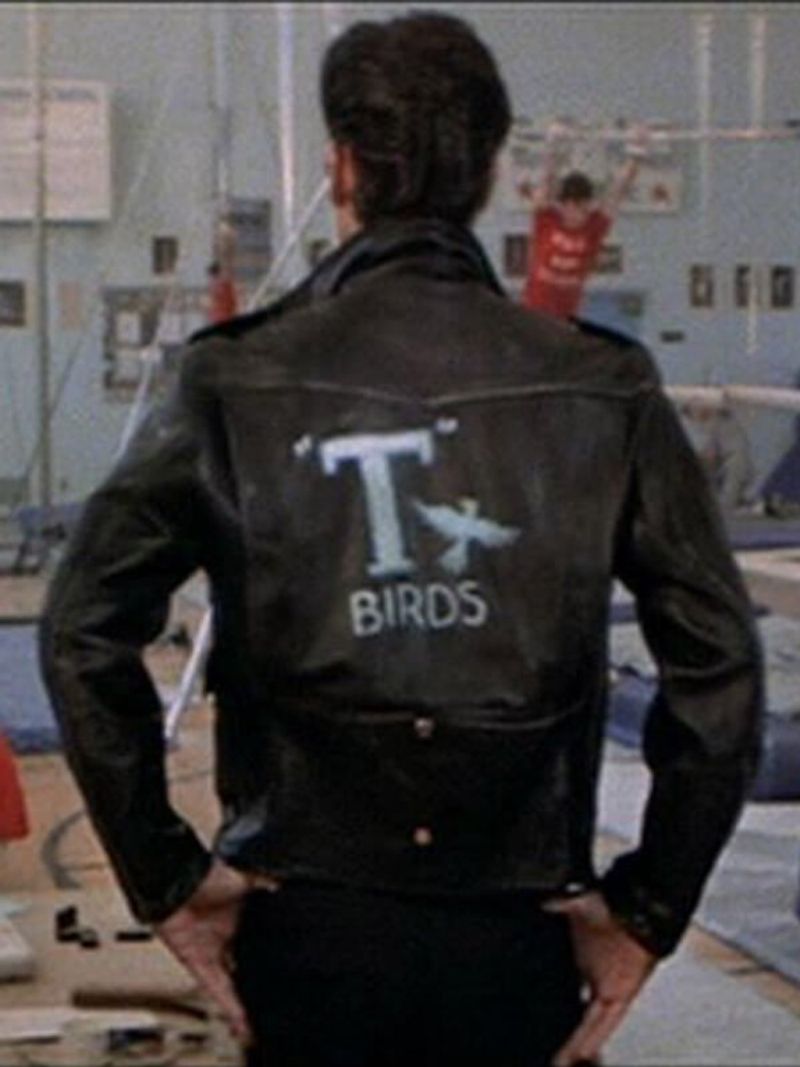
Nothing says “cool” quite like Danny Zuko’s black leather T-Birds jacket. When Travolta first appeared on screen with that slicked-back hair and perfect leather jacket in 1978, I swear every boy in my neighborhood suddenly started rolling their t-shirt sleeves and practicing their hair combing technique.
Costume designer Albert Wolsky created the ultimate bad-boy uniform with this seemingly simple black leather jacket emblazoned with the T-Birds logo. The genius was in the details – the perfect fit across the shoulders, the way it hung open just so, and those essential embellishments that transformed an ordinary jacket into a symbol of rebellious teenage brotherhood. The T-Birds patch wasn’t just decoration; it represented belonging, identity, and status.
What made this jacket truly iconic was how it captured that unique 1950s greaser aesthetic while simultaneously feeling fresh and relevant to 1970s audiences. The jacket became the centerpiece of a cultural phenomenon that sent leather jacket sales soaring. Even today, the silhouette remains instantly recognizable – the cropped length, the wide collar, the way it perfectly complemented those tight black pants and Cuban-heeled boots.
The jacket embodied teenage rebellion in its purest form – accessible enough to be attainable yet cool enough to be aspirational. It wasn’t just costume design; it was a blueprint for adolescent identity that continues to resonate with each new generation discovering the film.
12. Sigourney Weaver’s Futuristic Jumpsuit in ‘Alien’
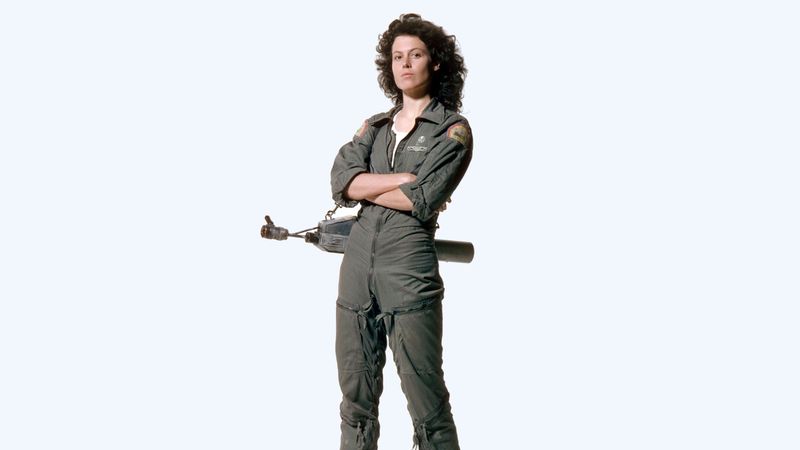
Ripley’s utilitarian jumpsuit in ‘Alien’ (1979) revolutionized how women were dressed in science fiction. The first time I watched this film at a campus sci-fi marathon, I was struck by how refreshingly practical her outfit was – finally, a female character dressed for surviving aliens rather than attracting the male gaze!
Costume designer John Mollo created a unisex beige cotton jumpsuit that prioritized function over form, with multiple pockets, rolled sleeves, and a comfortable fit that allowed for movement. What made this outfit groundbreaking was its deliberate plainness – it rejected the skintight, sexualized costumes typically forced upon women in science fiction. Instead, Ripley’s jumpsuit established her as a competent crew member rather than eye candy.
The genius of this costume was how it subtly reinforced the film’s themes of class struggle and corporate exploitation. The Nostromo crew wore standard-issue uniforms that marked them as working-class space truckers, not glamorous explorers. This jumpsuit helped create one of cinema’s most revolutionary female characters – one defined by her intelligence, resourcefulness, and courage rather than her appearance.
Its influence extended far beyond the film, inspiring designers to explore utilitarian aesthetics and challenging Hollywood’s assumptions about how female protagonists should look. Even decades later, when films want to signal a female character should be taken seriously, they often reach for that same practical jumpsuit silhouette.
13. Marlon Brando’s Army Fatigue Jacket in ‘Apocalypse Now’
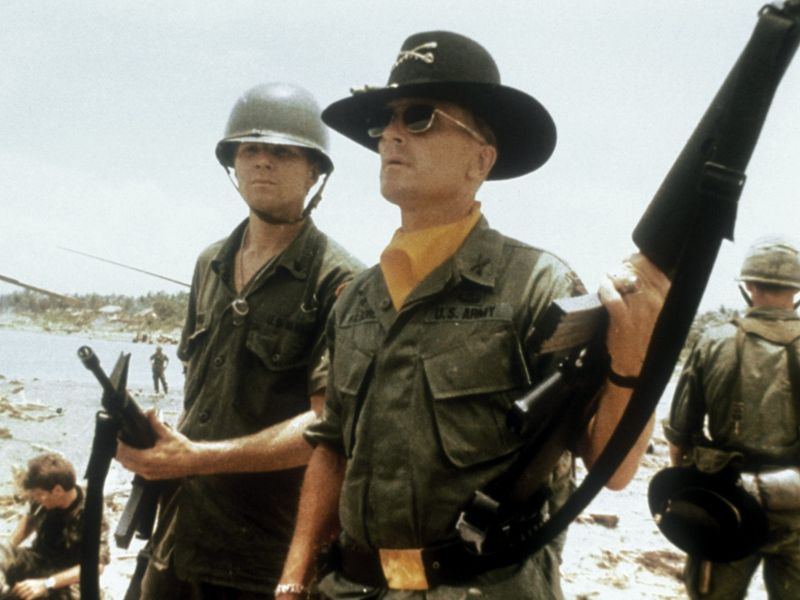
Colonel Kurtz’s weathered military jacket in ‘Apocalypse Now’ (1979) wasn’t just a costume – it was a visual manifestation of a soul corrupted by war. My film professor once spent an entire lecture analyzing how this single garment told the story of Kurtz’s descent from decorated officer to rogue demigod.
Costume designer Charles E. James created a jacket that looked like it had absorbed the horrors of Vietnam itself – sweat-stained, dirt-encrusted, and hanging loosely on Brando’s imposing frame. The standard-issue military garment, stripped of insignia and proper military bearing, perfectly represented Kurtz’s rejection of military hierarchy and embrace of primal authority. Its rumpled appearance and the way Brando wore it – unbuttoned, untucked – spoke volumes about a man who had abandoned military protocol for his own moral code.
What made this outfit truly iconic was how it transformed from uniform to personal mythology. The jacket became less military attire and more ceremonial robe for a man who had fashioned himself into a jungle deity. The contrast between its original purpose (to identify soldiers within a structured system) and Kurtz’s use of it (as he operated entirely outside that system) created a visual paradox as complex as the character himself.
This wasn’t fashion; it was character development through costume. The jacket’s influence extended beyond film, inspiring military-inspired fashion trends throughout the early 1980s and establishing the “distressed military jacket” as a symbol of countercultural rebellion.
14. Diane Keaton’s Red Dress in ‘Looking for Mr. Goodbar’
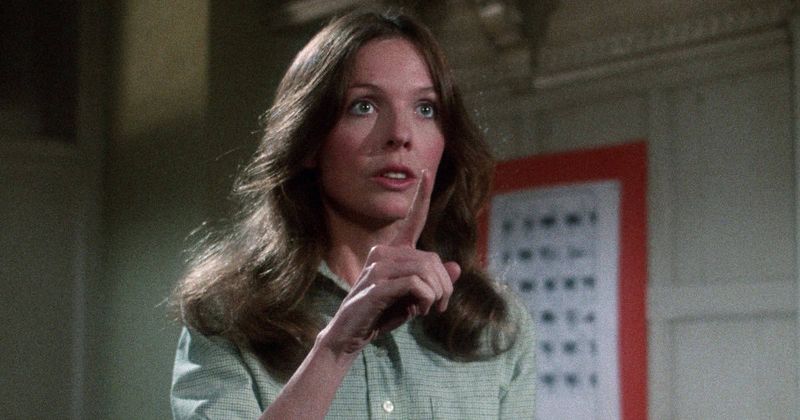
Before she became synonymous with menswear as Annie Hall, Diane Keaton delivered a fashion masterclass in feminine danger with her stunning red dress in ‘Looking for Mr. Goodbar’ (1977). I distinctly remember my older sister pointing to this outfit during a late-night cable viewing and whispering, “That’s what power dressing really looks like.”
Costume designer Ruth Morley created a deceptively simple red dress that managed to be simultaneously elegant and predatory. The color choice was brilliantly symbolic – red representing both desire and danger, perfectly capturing the film’s exploration of female sexuality and its potential consequences. The dress’s cut – flowing enough to move dramatically on the dance floor yet fitted enough to showcase Keaton’s figure – created the perfect visual representation of a woman embracing her sexual freedom while navigating its risks.
What made this outfit particularly significant was its context within the film’s exploration of 1970s single life. This wasn’t just a pretty dress; it was a character-defining statement about feminine agency in the post-sexual revolution era. The way Keaton wore it – with a mixture of confidence and vulnerability – perfectly embodied her character’s complex relationship with her own desires.
The dress became a visual shorthand for the film’s central themes about female sexuality, danger, and independence. Even decades later, it remains one of cinema’s most effective uses of costume to explore the complex territory where female empowerment meets potential exploitation.
15. Warren Beatty’s Pinstripe Suit in ‘Bugsy’
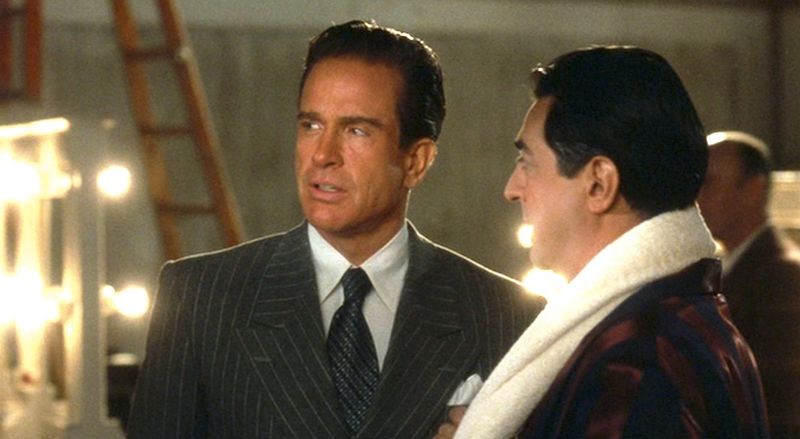
Warren Beatty’s immaculate pinstripe suit in ‘Bugsy’ (1991) may have depicted the 1940s, but its influence dominated 1970s gangster fashion after the film’s success. I remember my father pointing to this exact look in old family photos, claiming his wedding suit was inspired by Beatty’s mobster elegance!
Costume designer Albert Wolsky created a masterpiece of masculine refinement with this double-breasted pinstripe suit, featuring wide lapels, a perfectly fitted waist, and trousers with just the right break at the shoe. The genius lay in how the outfit balanced intimidating power with unexpected sophistication. The crisp white shirt, patterned tie, and meticulously folded pocket square weren’t just accessories – they were character development, showing Bugsy’s obsession with appearance and respectability despite his criminal activities.
What made this suit truly iconic was how it captured the gangster’s dual nature – ruthless criminal and aspiring gentleman. The pinstripes themselves served as a perfect visual metaphor: orderly, precise lines containing a man of chaotic violence and ambition. The suit’s influence extended far beyond the film, helping spark the 1970s revival of 1940s gangster chic in men’s fashion. The outfit’s enduring appeal lies in its timelessness – even decades later, it represents the ultimate in dangerous masculinity wrapped in civilized packaging. It wasn’t just costume design; it was a character study expressed through tailoring.
16. Meryl Streep’s Polka Dot Dress in ‘Kramer vs. Kramer’
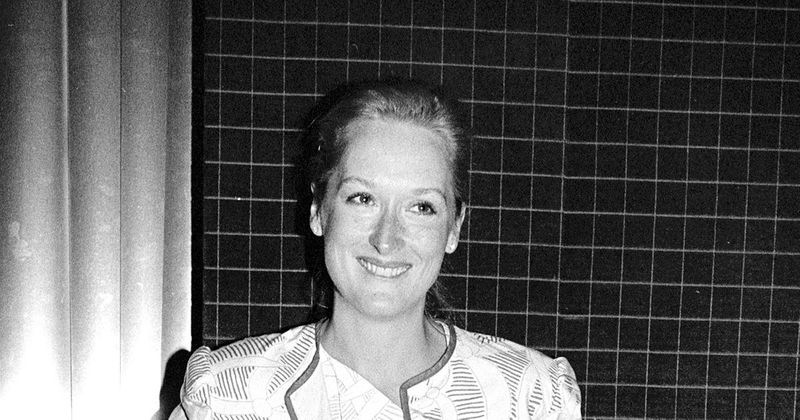
Sometimes the most powerful fashion statements are the quietest ones. Meryl Streep’s simple polka dot dress in ‘Kramer vs. Kramer’ (1979) perfectly captured the film’s emotional complexity through deceptive simplicity. When I first watched this with my mother as a teenager, she pointed to Streep’s outfit and whispered, “That’s exactly what we all wore when trying to be taken seriously.”
Costume designer Ruth Morley chose a navy blue dress with small white polka dots that struck the perfect balance between feminine tradition and emerging independence. The modest cut – knee-length with a subtle neckline – represented a woman caught between societal expectations and personal desires. What made this outfit particularly brilliant was how it evolved throughout the film, from perfectly pressed and properly accessorized to slightly rumpled and more casually worn, visually tracking Joanna Kramer’s journey toward self-discovery.
The genius of this costume lay in its deliberate ordinariness. Unlike many iconic film outfits, this dress wasn’t meant to dazzle but to resonate with real women navigating the changing landscape of gender roles in the late 1970s.
The polka dot pattern itself served as a perfect visual metaphor – traditional feminine print disrupted by small circles of white space, just as Joanna disrupted traditional motherhood by seeking her own identity. This wasn’t high fashion; it was something more powerful – a truthful representation of how everyday women used clothing to navigate their complex social positions during a time of rapid cultural change.
17. Richard Dreyfuss’s Hawaiian Shirt in ‘Jaws’
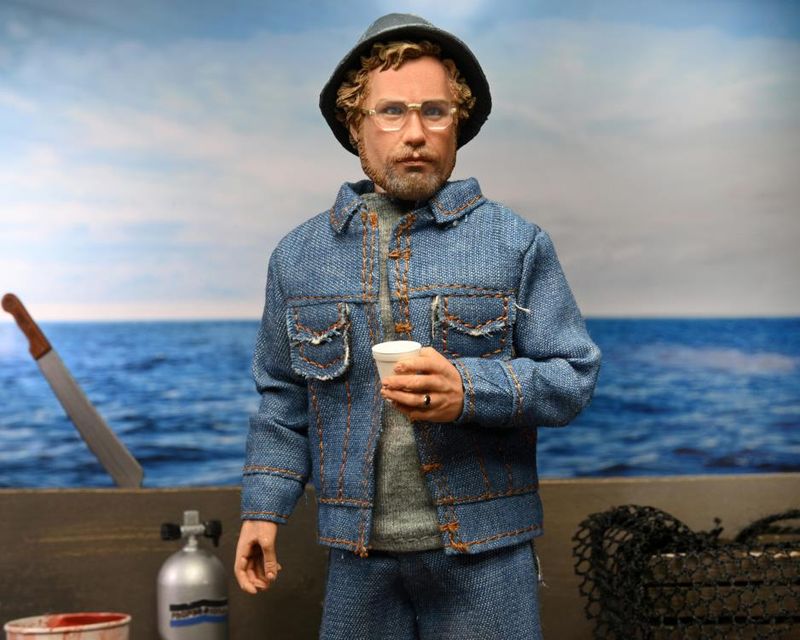
Who knew a loud Hawaiian shirt could communicate so much about a character? Richard Dreyfuss’s colorful button-up in ‘Jaws’ (1975) instantly established oceanographer Matt Hooper as an outsider in Amity Island’s buttoned-up community. My marine biologist cousin still jokes that this single costume piece set marine science fashion back decades!
Costume designer Louise Clark brilliantly used this tropical print shirt to visually separate Hooper from both the townspeople in their conservative attire and Quint in his rugged fishing clothes. The vibrant colors and casual styling weren’t just fashion choices – they established Hooper as someone who approached problems differently, bringing scientific expertise rather than local knowledge or practical experience. The shirt’s bold pattern mirrored Hooper’s bold personality – academic confidence bordering on arrogance.
What made this outfit truly inspired was how it subtly reinforced the film’s themes about class and education. The Hawaiian shirt wasn’t just casual; it was specifically the casual wear of a certain type of educated, upper-middle-class professional – someone who could afford to study sharks rather than fish them for a living.
Its influence extended beyond the film, helping establish the Hawaiian shirt as the unofficial uniform of scientists who did fieldwork rather than laboratory research. Even today, when filmmakers want to quickly establish a character as an educated outsider bringing expertise to a practical problem, they often reach for that same colorful pattern – a visual shorthand for academic knowledge in a practical setting.
